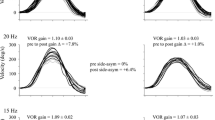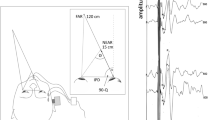Abstract
The vestibulo-ocular reflex (VOR) acts to maintain images stable on the retina by rotating the eyes in exactly the opposite direction, but with equal magnitude, to head velocity. When viewing a near target, this reflex has an increased response to compensate for the translation of the eyes relative to the target that acts to reduce retinal image slip. Previous studies have shown that retinal velocity error provides an important visual feedback signal to increase the low-frequency (<1 Hz) VOR response during near viewing. We sought to determine whether initial eye position and retinal image position error could provide enough information to substantially increase the high-frequency VOR gain (eye velocity/head velocity) during near viewing. Ten human subjects were tested using the scleral search coil technique during horizontal head impulses under different lighting conditions (constant dark, strobe light at 0.5, 1, 2, 4, 10, 15 Hz, constant light) while viewing near (9.5 ± 1.3 cm) and far (104 cm) targets. Our results showed that the VOR gain increased during near viewing compared to far viewing, even during constant dark. For the near target, there was an increase in VOR gain with increasing strobe frequency from 1.17 ± 0.17 in constant dark to 1.36 ± 0.27 in constant light, a 21 ± 9 % increase. For the far target, strobe frequency had no effect. Presentation order of strobe frequency (i.e. 0.5–15 vs. 15–0.5 Hz) did not affect the gain, but it did affect the vergence angle (angle between the two eye’s lines of sight). The VOR gain and vergence angles were constant during each trial. Our findings show that a retinal position error signal helps increase the vergence angle and could be invoking vestibular adaptation mechanisms to increase the high-frequency VOR response during near viewing. This is in contrast to the low-frequency VOR that depends more on retinal velocity error and predictive adaptation mechanisms.





Similar content being viewed by others
References
Aw ST, Haslwanter T, Halmagyi GM, Curthoys IS, Yavor RA, Todd MJ (1996) Three-dimensional vector analysis of the human vestibuloocular reflex in response to high-acceleration head rotations I. Responses in normal subjects. J Neurophysiol 76:4009–4020
Bello S, Paige GD, Highstein SM (1991) The squirrel monkey vestibulo-ocular reflex and adaptive plasticity in yaw, pitch, and roll. Exp Brain Res 87:57–66
Cohen H, Cohen B, Raphan T, Waespe W (1992) Habituation and adaptation of the vestibuloocular reflex: a model of differential control by the vestibulocerebellum. Exp Brain Res 90:526–538
Collewijn H, Smeets JB (2000) Early components of the human vestibulo-ocular response to head rotation: latency and gain. J Neurophysiol 84:376–389
Crane BT, Demer JL (1997) Human gaze stabilization during natural activities: translation, rotation, magnification, and target distance effects. J Neurophysiol 78:2129–2144
Crane BT, Demer JL (1998) Human horizontal vestibulo-ocular reflex initiation: effects of acceleration, target distance, and unilateral deafferentation. J Neurophysiol 80:1151–1166
Crane BT, Viirre ES, Demer JL (1997) The human horizontal vestibulo-ocular reflex during combined linear and angular acceleration. Exp Brain Res 114:304–320
Diggle PJ, Liang KY, Zeger SL (1994) Analysis of longitudinal data. Oxford University Press, New York
Gauthier GM, Robinson DA (1975) Adaptation of human’s vestibulo-ocular reflex to magnifying glasses. Brain Res 92:331–335
Gonshor A, Melvill Jones G (1976a) Short-term adaptive changes in the human vestibulo-ocular reflex arc. J Physiol 256:361–379
Gonshor A, Melvill Jones G (1976b) Extreme vestibulo-ocular adaptation induced by prolonged optical reversal of vision. J Physiol 256:381–414
Grossman GE, Leigh RJ, Abel LA, Lanska DJ, Thurston SE (1988) Frequency and velocity of rotational head perturbations during locomotion. Exp Brain Res 70:470–476
Han YH, Kumar AN, Reschke MF, Somers JT, Dell’Osso LF, Leigh RJ (2005) Vestibular and non-vestibular contributions to eye movements that compensate for head rotations during viewing of near targets. Exp Brain Res 165:294–304
Haslwanter T (1995) Mathematics of three-dimensional eye rotations. Vision Res 35:1727–1739
Hepp K (1990) On listing’s law. Commun Math Phys 132:285–292
Hine T, Thorn F (1987) Compensatory eye movements during active head rotation for near targets: effects of imagination, rapid head oscillation and vergence. Vision Res 27:1639–1657
Lasker DM, Ramat S, Carey JP, Minor LB (2002) Vergence-mediated modulation of the human horizontal angular VOR provides evidence of pathway-specific changes in VOR dynamics. Ann N Y Acad Sci 956:324–337
Leigh RJ, Brandt T (1993) A reevaluation of the vestibulo-ocular reflex: new ideas of its purpose, properties, neural substrate, and disorders. Neurology 43:1288–1295
Lewis RF, Clendaniel RA, Zee DS (2003) Vergence-dependent adaptation of the vestibulo-ocular reflex. Exp Brain Res 152:335–340
Luebke AE, Robinson DA (1988) Transition dynamics between pursuit and fixation suggest different systems. Vision Res 28:941–946
McLaughlin S (1967) Parametric adjustment in saccadic eye movements. Percept Psychophys 2:359–362
Melvill Jones G, Mandl G (1981) Motion sickness due to vision reversal: its absence in stroboscopic light. Ann N Y Acad Sci 374:303–311
Migliaccio AA, Schubert MC (2013) Unilateral adaptation of the human angular vestibulo-ocular reflex. J Assoc Res Otolaryngol 14:29–36
Migliaccio AA, Todd MJ (1999) Real-time rotation vectors. Australas Phys Eng Sci Med 22:73–80
Migliaccio AA, Cremer PD, Aw ST, Halmagyi GM, Curthoys IS, Minor LB, Todd MJ (2003) Vergence-mediated changes in the axis of eye rotation during the human vestibulo-ocular reflex can occur independent of eye position. Exp Brain Res 151:238–248
Migliaccio AA, Minor LB, Carey JP (2004) Vergence-mediated modulation of the human horizontal vestibulo-ocular reflex is eliminated by a partial peripheral gentamicin lesion. Exp Brain Res 159:92–98
Miller JM, Anstis T, Templeton WB (1981) Saccadic plasticity: parametric adaptive control by retinal feedback. J Exp Psychol Hum Percept Perform 7:356–366
Paige GD (1991) Linear vestibulo-ocular reflex (LVOR) and modulation by vergence. Acta Otolaryngol Suppl 481:282–286
Paige GD, Seidman SH (1999) Characteristics of the VOR in response to linear acceleration. Ann N Y Acad Sci 871:123–135
Paige GD, Tomko DL (1991) Eye movement responses to linear head motion in the squirrel monkey. I. Basic characteristics. J Neurophysiol 65:1170–1182
Paige GD, Telford L, Seidman SH, Barnes GR (1998) Human vestibuloocular reflex and its interactions with vision and fixation distance during linear and angular head movement. J Neurophysiol 80:2391–2404
Schubert MC, Migliaccio AA, Minor LB, Clendaniel RA (2008) Retention of VOR gain following short-term VOR adaptation. Exp Brain Res 187:117–127
Shelhamer M, Tiliket C, Roberts D, Kramer PD, Zee DS (1994) Short-term vestibulo-ocular reflex adaptation in humans. II. Error signals. Exp Brain Res 100:328–336
Snyder LH, King WM (1992) Effect of viewing distance and location of the axis of head rotation on the monkey’s vestibuloocular reflex. I. Eye movement responses. J Neurophysiol 67:861–874
Snyder LH, Lawrence DM, King WM (1992) Changes in vestibulo-ocular reflex (VOR) anticipate changes in vergence angle in monkey. Vision Res 32:569–575
Straumann D, Zee DS, Solomon D, Lasker AG, Roberts DC (1995) Transient torsion during and after saccades. Vision Res 35(23–24):3321–3334
Viirre E, Tweed D, Milner K, Vilis T (1986) A reexamination of the gain of the vestibuloocular reflex. J Neurophysiol 56:439–450
Yakushin SB, Raphan T, Cohen B (2000) Context-specific adaptation of the vertical vestibuloocular reflex with regard to gravity. J Neurophysiol 84:3067–3071
Acknowledgments
A. A. Migliaccio was supported by an NHRMRC (Australia) Biomedical CDA 568736 grant.
Author information
Authors and Affiliations
Corresponding author
Rights and permissions
About this article
Cite this article
Chim, D., Lasker, D.M. & Migliaccio, A.A. Visual contribution to the high-frequency human angular vestibulo-ocular reflex. Exp Brain Res 230, 127–135 (2013). https://doi.org/10.1007/s00221-013-3635-9
Received:
Accepted:
Published:
Issue Date:
DOI: https://doi.org/10.1007/s00221-013-3635-9




